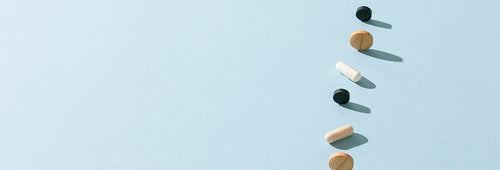
Recyclable, compostable or glass bottles: which packaging to choose?
Like a growing number of French people, you probably also feel concerned about ecology - and that is to your credit.
According to the Ministry of Ecological Transition, the trend towards better waste recovery is starting to bear fruit. Indeed, all waste combined, the recycling rate increased from 60% in 2010 to 66% in 2020 (for material and organic recycling in any case). At Novoma, we intend to participate in this movement!
For this reason, the question of the packaging of our food supplements inevitably arises. As transparency is one of our major commitments , we explain to you, through this article, why we have chosen recycled plastic packaging for our food supplements.
An ecological approach with plastic bottles? Yes, you read correctly !
Why, in fact, not select glass bottles or compostable products? We have looked into the matter, taking into account your satisfaction and your experience, which remain our priorities.
Here is the summary of our thoughts 🧐

What packaging should we choose for our food supplement bottles?
Of course, there aren't fifty solutions either. But we wanted to study very closely the options available to us, who wish to be more eco-responsible.
Our observation? Here it is :
Glass, a bad idea
Glass, ideal for preserving food products, does not bind bacteria and is easy to clean for repeated use over the long term. Furthermore, it can be 100% recycled , as many times as desired, without losing its properties.
However, glass does not only have qualities:
- Its main fault? Its manufacturing (or recycling) is energy-intensive . After extraction from the soil, silica sand is crushed, mixed and heated with soda ash and limestone at very high temperatures to obtain fusion;
- Glass is much heavier than any other packaging, increasing transport costs and its environmental impact;
- The glass breaks ! You know this, just as you may have already deplored the fact that carriers are not always very careful with your packages... The satisfaction of our customers is too important to take the risk of them receiving a broken bottle upon receipt. of their package. However, its use could be optimized if a long-abandoned practice were to become widespread: the glass deposit. But again, this process is not always applicable, especially for online commerce.
Cardboard or compostable products
Cardboard, provided it meets the CE 1935-2004 standard, can be used in food packaging factories. Very light, it could have been ideal for our bottles. However, to ensure the best preservation of our food supplements, it must be covered with a thin layer of plastic on the inside. In addition, some cardboard boxes, although recyclable, are not compostable.
A compostable bottle also seems a good alternative, but its lifespan is short, because it is single-use . In addition, it is your responsibility to find an industrial composter dedicated to your packaging, so that it is transformed into organic compost in a controlled environment. As these industrial composters are still few in number in France, we have abandoned this idea.
Plastic
Yes, plastic has a very bad press, particularly for its pollution of our oceans, which is highly regrettable. However, we still found some significant qualities in it:
- low manufacturing cost;
- often recyclable ;
- solid ;
- easy and light to transport (reduced carbon footprint ).
Furthermore, new types of plastic are proving to be much less harmful than others, both for our beautiful planet and for your health.
- PLA plastic (plant plastic): product made from plants, not only 100% biosourced, but above all biodegradable, because compostable.
- PET plastic : recyclable (but not infinitely), it is recognizable by its logo with three arrows (Möbius circle) and the number 1. You are assured, provided you sort your waste well, that it will be 100% recycled.
But of course, not all plastics are created equal!
Our choice: R-PET for recycled AND recyclable packaging
As you will have understood, trying to adopt an eco-responsible attitude is not that simple. After weighing the pros and cons, we chose recycled AND recyclable plastic packaging. Our bottles are therefore made of rPET. But do you know this material that already reigns in your home?
First of all, what is PET?
PET ( polyethylene terephthalate ) is a plastic that belongs to the thermoplastic family. Mainly used for the manufacture of bottles, flasks, jars, films, etc., it is a synthetic polymer produced by polycondensation of ethylene glycol with terephthalic acid. We find it all around us: textiles, credit cards, bottles, pipes, cans and cans...
Is PET harmful to health?
If we chose it, you can imagine that the answer is no! PET, although often criticized by rumor, is not harmful to your health. The use of PET is subject to European regulations and undergoes drastic controls.
Let us cite for example this study , led by the European Health Safety Authority, which concludes that “[…] the recycled PET obtained by this process does not pose a safety problem, when it is used up to 100% for the manufacture of materials and articles intended to come into contact with all types of foodstuffs […]”.
The advantages of PET
This material is light, safe and durable. Its carbon footprint is well below that of glass. On the one hand, it requires less energy for its manufacture, on the other hand, its solidity makes it possible to reduce protective packaging. Another advantage, and not the least: it is 100% recyclable, unlike other plastics.
PET and R-PET, what’s the difference?
R-PET , unlike PET, is a plastic that has already been used and recycled . R-PET is made from 100% PET material . The civic gesture of putting plastic waste in a yellow bin allows recycling plants to manufacture new products, including recyclable and recycled packaging.
Furthermore, R-PET requires less energy during its manufacture, unlike that of PET made from raw materials. Our food supplement bottles, made from R-PET , are part of a circular economy that supplies an entire industry.
The beginnings of a virtuous circle?
Faced with the environmental emergency, we decided to give a second life to an already existing plastic material, which had become embarrassing. This is our current way, as an eco-responsible company, to make a contribution, while guaranteeing your satisfaction, which is so precious to us 🌞













